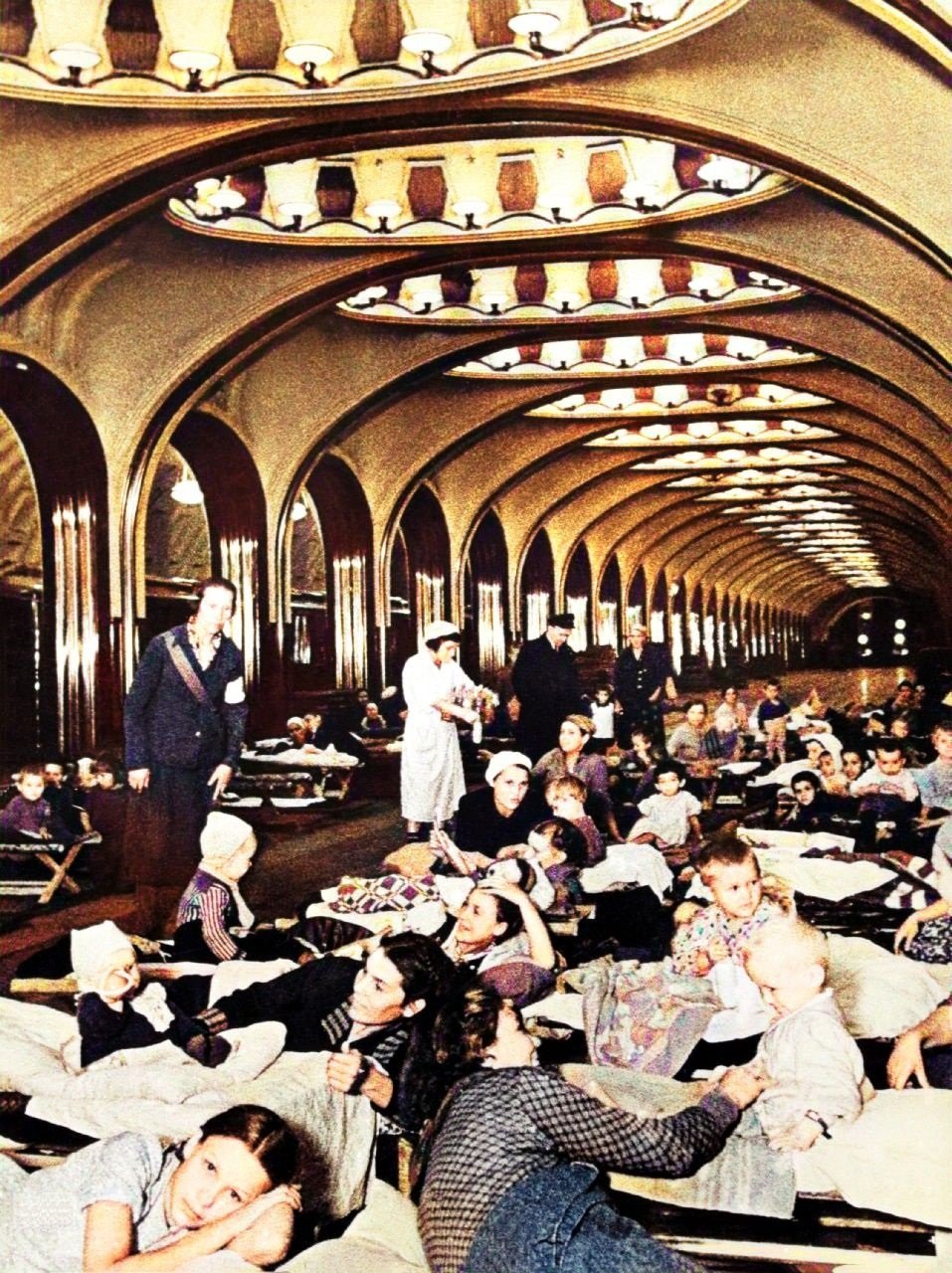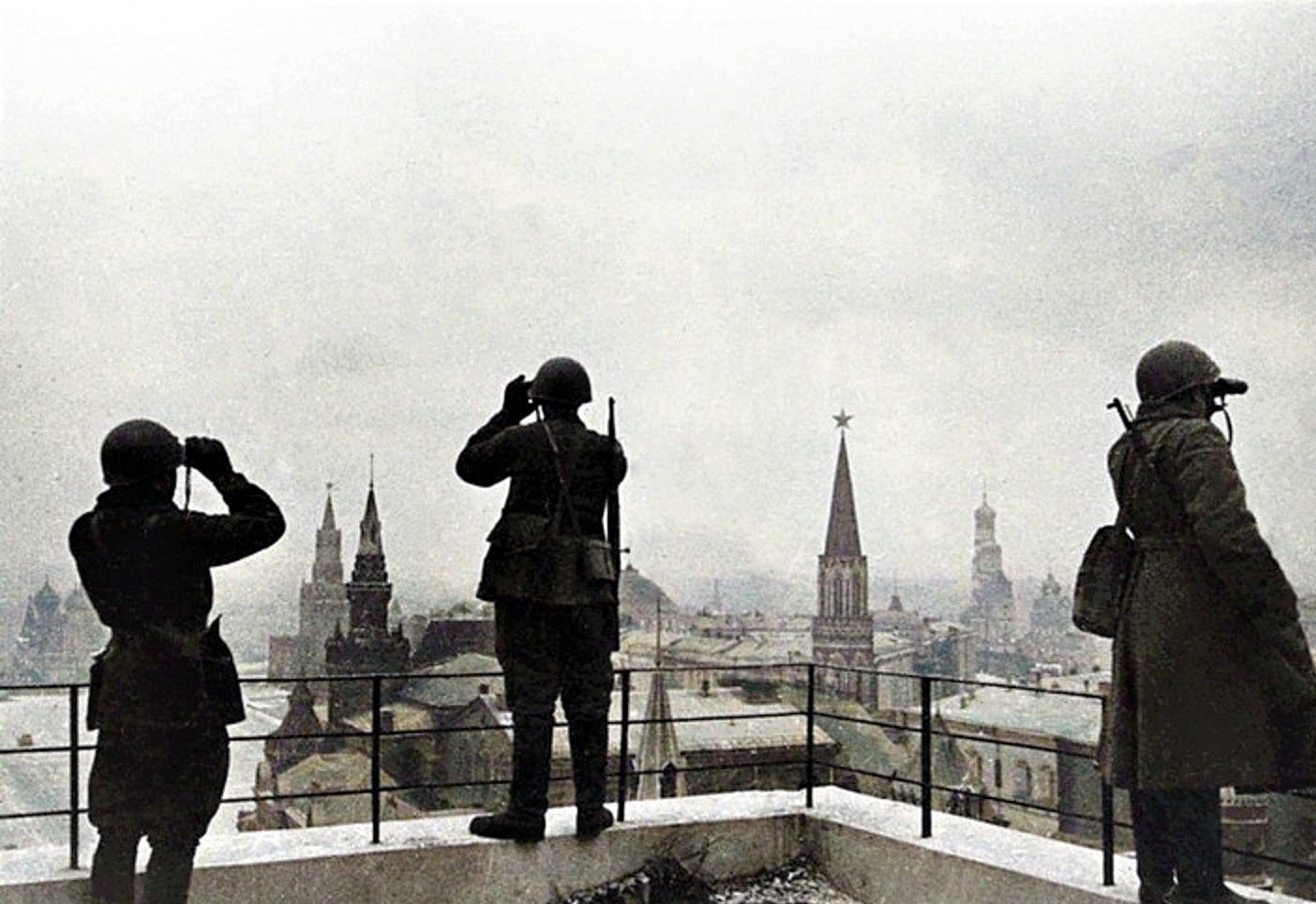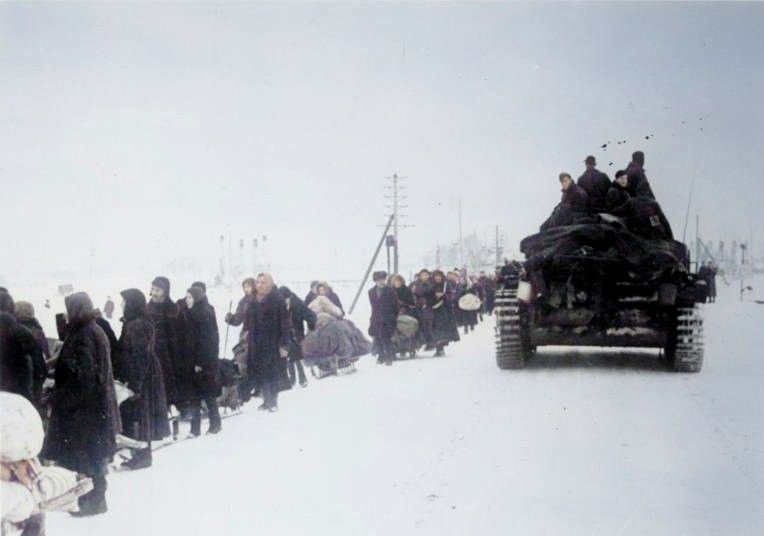The Battle of Moscow
Chapter 13
“Comrades, the whole world is looking to you as the force capable of destroying the plundering hordes of German invaders.”
7 November, 1941 - 7 January, 1942
The relentless advance of the Wehrmacht into the Soviet Union had continued unabated since the initial invasion of the country at the end of June, 1941, and as the winter set in the Germans were bearing down on Moscow itself. Operation Typhoon, the Battle of Moscow, was about to begin in earnest.
Barricades stretch across a Moscow street
Russian International News Agency
The efforts of the Red Army, although not yet successful in halting the invasion, had nonetheless slowed the Germans, and as winter loomed they found themselves stretched thin across the enormous expanse of the USSR, as Soviet defenses stiffened. Inside the Soviet capital, the city was being prepared for a siege, with streets being barricaded and citizens taking shelter inside the Metro stations from the Luftwaffe’s raids. Evacuations of the government had commenced in mid-October, although Stalin himself had remained in the Kremlin. Essential industries, including entire factories worth of equipment, were also evacuated toward the Urals. The bridges leading into Moscow were wired for demolition, as were many within the city. Crews of civilian women were tasked with digging tank traps and trenches outside the city, and on 7 November the October Revolution Parade had been held on Red Square as scheduled, with the soldiers marching directly from the square to the frontline outside the city. The day before Stalin had held a speech to assembled veterans of the Revolution, ensconced within the halls of the Mayakovsky Metro Station deep below the city streets.
Civilians taking shelter in the Moscow Metro as the Germans close in on the Soviet capitol
Mos.ru
Just as the Wehrmacht closed in on the Soviet capital, so did the winter. Temperatures dropped well below zero by 12 November, and frostbite became a serious problem for the Germans. The Soviets responded with the deployment of ski troops and other cold weather specialists, as German sentries froze to death at their posts. In addition, Soviet reinforcements were pouring in by the day.
Soviet soldiers march down a Moscow street directly to the frontline
Russian International News Agency
The Soviet defenses around the city had been arrayed in a line from Kalinin to Kaluga, and was strongly held by Soviet forces brought in from Siberia in October. In the face of this threat, the Germans elected to envelop the city in a manner similar to what had been previously done at cities like Smolensk and Kiev, successfully flanking the line and forcing the defenders to pull back toward the city to prevent destruction. The advance had been slowed by the mud but as November began and temperatures dropped, the Germans prepared to resume Operation Typhoon and take the city.
German troops advance on Moscow
On 15 November, the attack on Moscow resumed. In the south, the German 2nd Panzer Army launched its attack from the Tula Sector toward Kolomna, while the 3rd and 4th Panzer Groups pushed toward the Ivankovo Reservoir and Klin to the north. The Soviet lines buckled under the attacks, with the Red Army making a fighting retreat toward the city, and the strongly defended city of Tula had to be bypassed by the Germans altogether. But the Soviets mounted strong resistance, preventing the Germans from exploiting any breakthroughs.
Soviet cavalry enter a village
Russian International News Agency
Klin fell to the Germans on 23 November after heavy fighting, and by 27 November the Germans had crossed the Volga Canal, leaving their spearheads only 22 miles from the Kremlin itself before being driven back from their bridgehead by strong counterattacks. In the south, the Germans, despite flanking attacks near Tula, were advancing on the Soviet Western Front Headquarters in Kashira, and the Soviets responded by deploying their cavalry against the advance, eventually turning General Heinz Guderian’s 2nd Panzer Army back after heavy fighting.
Soviet IL2 Sturmoviks over the Moscow Front
Russian International News Agency
As November came to an end the Germans were beginning to slow down, the weight of the Soviet counterattacks as well as the weather conditions exacting a heavy toll on their forces. As the advance in the south bogged down, they attempted another assault directly eastward down the highway from Minsk on 1 December, but were driven back to their starting point after several days. Elsewhere, the Germans reached the suburb of Khimki, representing the furthest advance of the Wehrmacht into the city, only twelve miles from the Kremlin.
Soviet spotters on a roof overlooking the Kremlin
Despite pushing so close to their objective, the Germans were out of steam. German Army Chief of Staff, General Franz Halder, reported significant new Soviet forces arriving on 27 November, as misgivings began to be felt in the Kremlin and in Berlin. The Germans launched another attack on 3 December, aiming to cut off Tula, but the temperature dropped to -35 degrees centigrade (-31 degrees Fahrenheit), leading to stalled vehicles and rampant frostbite.
Soviet soldiers manning a foxhole with a PTRD41 anti-tank rifle
At 0300 on 5 December the Soviets launched a massive counteroffensive in the midst of a blizzard, with a total of 88 divisions against the 67 divisions of the Wehrmacht. Overwhelmed by the conditions as well as the numbers of the Red Army, the Germans began to pull back despite the orders of the Fuhrer to hold at all costs.
German soldiers trudge through a snowstorm
Russian International News Agency
Orders came down from OKW on 8 December calling for all German forces near Moscow to assume a defensive posture, but the situation at the front was chaos. The Germans were unable to dig in where they stood and continued to pull back away from the Soviet capital. An attempt was made by German senior officers to salvage the situation by issuing orders on 12 December for the formation of a new defensive line along the Oka River, but an enraged Hitler cancelled these as soon as he found out. The situation also led to shakeups of German leadership, with Generals Guderian, Strauss and Hoepner (commanders of the formations near Moscow) relived of command, and Field Marshal Walther von Brauchitsch, Commander in Chief of the German Army was forcibly retired, with Hitler personally taking command.
Soviet soldiers man the line outside Moscow
Russian International News Agency
By 16 December Tula had been relived by advancing Red Army troops, with the German XXXV Corps enveloped and destroyed in the process. An attempt to do the same with the 3rd Panzer Army was less successful as the Germans escaped westward. On the same day Kalinin was retaken by the Red Army. Kaluga was retaken on 26 December, and on New Year’s Eve Kozelsk was taken, even further west than the proposed German defensive line.
Civilians trudge through the snow past a German panzer
German Federal Archives
Hitler issued orders on 2 January for the 9th Army to stop its retreat from the Kalinin Sector and hold its ground, but on that day the Soviets broke through the lines near Rzhev. The offensive slowed and eventually stopped on 7 January, with the Soviets having pushing as far west as 150 miles in some areas. By now the Soviets were exhausted, and attempts to continue the advance failed as the Germans consolidated their lines ad dug in. The arrival of Luftwaffe reinforcements also served to stabilize the lines, as German airpower was brought to bear as the weather cleared.
General Konstantin Rokossovsky with his staff amongst abandoned German vehicles
Russian International News Agency
The Battle of Moscow was essentially over on 7 January, 1942. It represented the first major defeat of the Wehrmacht since the beginning of the war, and came as a vital boost to morale both for the USSR and the Allies as a whole, who were at the time reeling from the entry of Japan into the war. The front remained close to the city, and attacks on the Germans near Rzhev had failed with heavy casualties. Indeed, casualties had been very high for both sides during the Battle for Moscow, with almost half a million Soviet casualties and nearly 200,000 German casualties.
Soviet soldiers stand guard as German prisoners pass
Mil.ru
The war on the Eastern Front, as well as the world at large, was still far from over. As 1942 dawned the war had expanded around the globe, and was growing ever more vicious.












